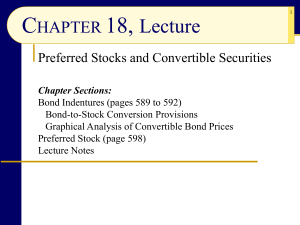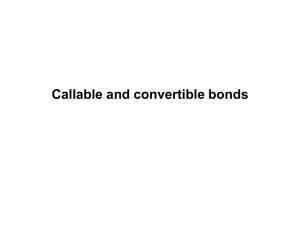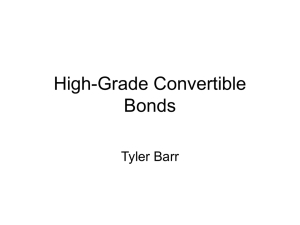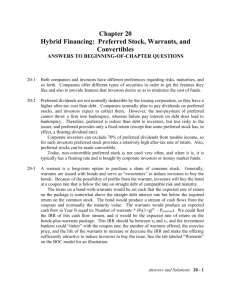Chapter 7
advertisement
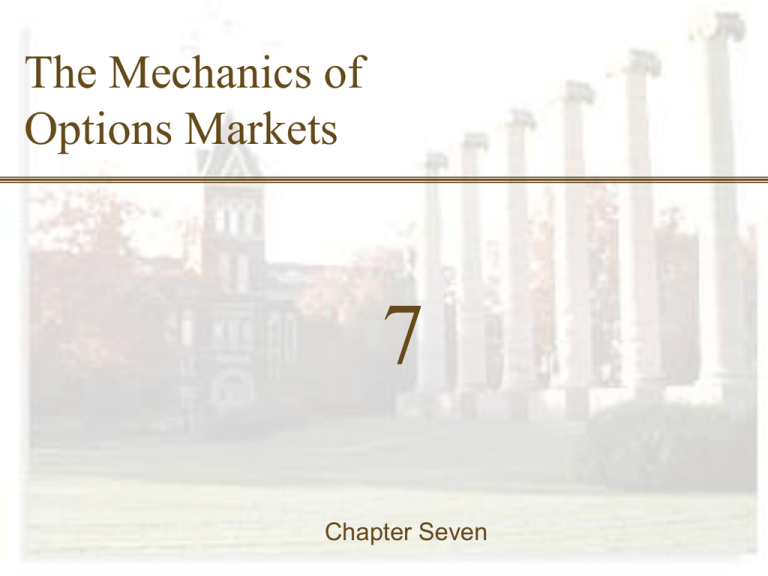
7-0 Finance 457 The Mechanics of Options Markets 7 Chapter Seven 7-1 Finance 457 Mechanics of Options Markets 7.1 Underlying Assets 7.2 Specifications of stock options 7.3 Newspaper Quotes 7.4 Trading 7.5 Commissions 7.6 Margins 7.7 The Options Clearing Corporation 7.8 Regulation 7.9 Taxation 7.10 Warrants, ESOs and Convertibles 7.11 Over-the-counter markets Summary and Conclusions 7-2 Finance 457 Options Contracts: Preliminaries • An option gives the holder the right, but not the obligation, to buy or sell a given quantity of an asset on (or perhaps before) a given date, at prices agreed upon today. • Calls versus Puts – Call options gives the holder the right, but not the obligation, to buy a given quantity of some asset at some time in the future, at prices agreed upon today. When exercising a call option, you “call in” the asset. – Put options gives the holder the right, but not the obligation, to sell a given quantity of an asset at some time in the future, at prices agreed upon today. When exercising a put, you “put” the asset to someone. 7-3 Finance 457 Options Contracts: Preliminaries • Exercising the Option – The act of buying or selling the underlying asset through the option contract. • Strike Price or Exercise Price – Refers to the fixed price in the option contract at which the holder can buy or sell the underlying asset. • Expiry – The maturity date of the option is referred to as the expiration date, or the expiry. • European versus American options – European options can be exercised only at expiry. – American options can be exercised at any time up to expiry. 7-4 Finance 457 Options Contracts: Preliminaries • In-the-Money – The exercise price is less than the spot price of the underlying asset. • At-the-Money – The exercise price is equal to the spot price of the underlying asset. • Out-of-the-Money – The exercise price is more than the spot price of the underlying asset. 7-5 Finance 457 Options Contracts: Preliminaries • Intrinsic Value – The difference between the exercise price of the option and the spot price of the underlying asset. • Speculative Value – The difference between the option premium and the intrinsic value of the option. Option Premium = Intrinsic Value + Speculative Value 7-6 Finance 457 7.1 Underlying Assets • Stocks – CBOE, PHLX, AMEX, and the Pacific Exchange – Trade on more than 500 different stocks, on round lots • Stock indices – Settlement is always in cash. • Foreign Currencies – PHLX – European and American options on a variety of currencies • Futures Contracts – The futures contract normally matures just after the expiry of the option 7-7 Finance 457 7.2 Specifications of stock options • Expiry – 10:59 CST on the Saturday immediately following the third Friday of the month. – The last trading day is the third Friday. – Holder of the option has until 4:30 of that Friday to exercise. – His broker has until 10:59 the next day to notify the exchange • Expiry Cycles: • January – January, April, July, October • February – February, May, August, November • March – March, June, September, December • When one option expires, trading in another begins. 7-8 Finance 457 7.2 Specifications of stock options • Strike Price – When a new expiration date is introduced, the two or three strike prices closest to the current stock price are usually selected by the exchange. – If the stock prices move outside this range, new options will be introduced. • Terminology: • An option class refers to all puts on firm XYZ or all calls on ABC. • An option series consists of all the options of a given class with the same expiry and strike (e.g. the IBM October 50 calls) 7-9 Finance 457 7.2 Specifications of stock options • Dividends and Splits – Exchange traded options are adjusted for stock splits and stock dividends. – Exchange traded options are generally not adjusted for cash dividends • Position Limits – A position limit is the maximum number of option contracts that an investor can hold on one side of the market. – Short calls and long puts are on the same side. • Exercise Limits – Equals the position limit. • Controversial issue. 7-10 Finance 457 Reading The Wall Street Journal Option/Strike Exp. 130 Oct IBM 130 Jan 138¼ 135 Jul 138¼ 135 Aug 138¼ 140 Jul 138¼ 140 Aug 138¼ --Put---Call-Vol. Last Vol. Last 5¼ 107 364 15¼ 9¼ 420 112 19½ 4¾ 2431 13/16 2365 5½ 94 9¼ 1231 2¾ 427 1¾ 1826 7½ 58 6½ 2193 7-11 Finance 457 Reading The Wall Street Journal This option has a strike price of $135; Option/Strike Exp. 130 Oct IBM 130 Jan 138¼ 135 Jul 138¼ 135 Aug 138¼ 140 Jul 138¼ 140 Aug 138¼ --Put---Call-Vol. Last Vol. Last 5¼ 107 364 15¼ 9¼ 420 112 19½ 4¾ 2431 13/16 2365 5½ 94 9¼ 1231 2¾ 427 1¾ 1826 7½ 58 6½ 2193 a recent price for the stock is $138.25 July is the expiration month 7-12 Finance 457 Reading The Wall Street Journal This makes a call option with this exercise price in-themoney by $3.25 = $138¼ – $135. Option/Strike Exp. 130 Oct IBM 130 Jan 138¼ 135 Jul 138¼ 135 Aug 138¼ 140 Jul 138¼ 140 Aug 138¼ --Put---Call-Vol. Last Vol. Last 5¼ 107 364 15¼ 9¼ 420 112 19½ 4¾ 2431 13/16 2365 5½ 94 9¼ 1231 2¾ 427 1¾ 1826 7½ 58 6½ 2193 Puts with this exercise price are out-of-the-money. 7-13 Finance 457 Reading The Wall Street Journal Option/Strike Exp. 130 Oct IBM 130 Jan 138¼ 135 Jul 138¼ 135 Aug 138¼ 140 Jul 138¼ 140 Aug 138¼ --Put---Call-Vol. Last Vol. Last 5¼ 107 364 15¼ 9¼ 420 112 19½ 4¾ 2431 13/16 2365 5½ 94 9¼ 1231 2¾ 427 1¾ 1826 7½ 58 6½ 2193 On this day, 2,365 call options with this exercise price were traded. 7-14 Reading The Wall Street Journal Finance 457 The CALL option with a strike price of $135 is trading for $4.75. Option/Strike Exp. 130 Oct IBM 130 Jan 138¼ 135 Jul 138¼ 135 Aug 138¼ 140 Jul 138¼ 140 Aug 138¼ --Put---Call-Vol. Last Vol. Last 5¼ 107 364 15¼ 9¼ 420 112 19½ 4¾ 2431 13/16 2365 5½ 94 9¼ 1231 2¾ 427 1¾ 1826 7½ 58 6½ 2193 Since the option is on 100 shares of stock, buying this option would cost $475 plus commissions. 7-15 Finance 457 Reading The Wall Street Journal Option/Strike Exp. 130 Oct IBM 130 Jan 138¼ 135 Jul 138¼ 135 Aug 138¼ 140 Jul 138¼ 140 Aug 138¼ --Put---Call-Vol. Last Vol. Last 5¼ 107 364 15¼ 9¼ 420 112 19½ 4¾ 2431 13/16 2365 5½ 94 9¼ 1231 2¾ 427 1¾ 1826 7½ 58 6½ 2193 On this day, 2,431 put options with this exercise price were traded. 7-16 Finance 457 Reading The Wall Street Journal The PUT option with a strike price of $135 is trading for $.8125. Option/Strike Exp. 130 Oct IBM 130 Jan 138¼ 135 Jul 138¼ 135 Aug 138¼ 140 Jul 138¼ 140 Aug 138¼ --Put---Call-Vol. Last Vol. Last 5¼ 107 364 15¼ 9¼ 420 112 19½ 4¾ 2431 13/16 2365 5½ 94 9¼ 1231 2¾ 427 1¾ 1826 7½ 58 6½ 2193 Since the option is on 100 shares of stock, buying this option would cost $81.25 plus commissions. 7-17 Finance 457 7.4 Trading • Market Makers – Offer bid and ask quotes on the option. – Market makers ensure that buy and sell orders can always be executed at some price without delay. – The bid-ask spread is their compensation for this liquidity intermediation • Offsetting Orders – An investor can close out a long position by issuing an offsetting order to sell the same option. – An investor can close out a short position by issuing an offsetting order to buy the same option. 7-18 Finance 457 7.5 Commissions • Commissions vary substantially from one broker to another. • A hidden cost is the bid-ask spread 7-19 Finance 457 7.6 Margins • Since options already have plenty of leverage, option premia must be paid in full. 7-20 Finance 457 7.6 Margins • Naked – If you write a call on shares you don’t own. – The initial margin is the greater of: • 100% of the proceeds plus 20% of the underlying share price less the amount if any by which the option is out of the money • 100% of the option proceeds plus 10% of the underlying share price • Covered Call – IF the option is out of the money, no margin is required 7-21 Finance 457 7.7 The Options Clearing Corporation • Has the same function as the • Exercising an option clearinghouse in the futures – The OCC randomly selects a markets. member with an outstanding • Guarantees option writers fulfill short position in the option. their obligations and keeps a – The member then selects a record of all long and short particular investor who has positions. written the option. – At expiry, all in-the-money options should be exercised unless transactions costs are too high. 7-22 Finance 457 7.8 Regulation • Both the exchange and the OCC have rules governing the behavior of traders. • Both federal and state regulatory authorities exist. • SEC CFTC • There haven’t been any huge scandals, so we leave them alone. • So far 7-23 Finance 457 7.9 Taxation • Determining the tax implications of options strategies can be tricky. 7-24 Finance 457 7.10 Warrants, Executive Stock Options and Convertibles • The important questions are: – How can warrants and convertibles be valued? – What impact do warrants and convertibles have on firm value? – What are the differences between warrants, convertibles and call options? – Under what circumstances are warrants and convertibles converted into common stock? 7-25 Finance 457 Warrants • Warrants are call options that give the holder the right, but not the obligation, to buy shares of common stock directly from a company at a fixed price for a given period of time. • Warrants tend to have longer maturity periods than exchange traded options. • Warrants are generally issued with privately placed bonds as an “equity kicker”. • Warrants are also combined with new issues of common stock and preferred stock, given to investment bankers as compensation for underwriting services. – In this case, they are often referred to as a Green Shoe Option. 7-26 Finance 457 The Difference Between Warrants and Call Options • When a warrant is exercised, a firm must issue new shares of stock. • This can have the effect of diluting the claims of existing shareholders. 7-27 Finance 457 Dilution Example • Imagine that Mr. Armstrong and Mr. LeMond are shareholders in a firm whose only asset is 10 ounces of gold. • When they incorporated, each man contributed 5 ounces of gold, then valued at $300 per ounce. They printed up two stock certificates, and named the firm LegStrong, Inc.. • Suppose that Mr. Armstrong decides to sell Mr. Mercx a call option issued on Mr. Armstrong’s share. The call gives Mr. Mercx the option to buy Mr. Armstong’s share for $1,500. • If this call finishes in-the-money, Mr. Mercx will exercise, Mr. Armstrong will tender his share. • Nothing will change for the firm except the names of the shareholders. 7-28 Finance 457 Dilution Example • Suppose that Mr. Armstrong and Mr. LeMond meet as the board of directors of LegStrong. The board decides to sell Mr. Mercx a warrant. The warrant gives Mr. Mercx the option to buy one share for $1,500. • Suppose the warrant finishes in-the-money, (gold increased to $350 per ounce). Mr. Mercx will exercise. The firm will print up one new share. 7-29 Finance 457 Dilution Example • The balance sheet of LegStrong Inc. would change in the following way: Balance Sheet Before (Book Value) Assets Liabilities and Equity Gold: $3,000 Debt 0 Equity $3,000 (2 shares) Total Assets $3,000 Total $3,000 7-30 Finance 457 Dilution • The balance sheet of LegStrong Inc. would change in the following way: Balance Sheet Before (Market Value) Assets Liabilities and Equity Gold: $3,500 Debt 0 Equity $3,500 (2 shares) Total Assets $3,500 Total $3,500 7-31 Finance 457 Dilution • The balance sheet of LegStrong Inc. would change in the following way: Balance Sheet After (Market Value) Assets Liabilities and Equity Gold: $3,500 Debt 0 Cash: $1,500 Equity $5,000 (3 shares) Total Assets $5,000 Total $5,000 Note that Mr. Armstrong’s claim falls in value from $1,750 = $3,500 ÷ 2 to $1,666.67 = $5,000 ÷ 3 7-32 Finance 457 Convertible Bonds • A convertible bond is similar to a bond with warrants. • The most important difference is that a bond with warrants can be separated into different securities and a convertible bond cannot. • Recall that the minimum (floor) value of convertible: – Straight or “intrinsic” bond value – Conversion value • The conversion option has value. 7-33 Finance 457 The Value of Convertible Bonds The value of a convertible bond has three components: 1. Straight bond value 2. Conversion value 3. Option value 7-34 Finance 457 Convertible Bond Problem • Litespeed, Inc., just issued a zero coupon convertible bond due in 10 years. • The conversion ratio is 25 shares. • The appropriate interest rate is 10%. • The current stock price is $12 per share. • Each convertible is trading at $400 in the market. – What is the straight bond value? – What is the conversion value? – What is the option value of the bond? 7-35 Finance 457 Convertible Bond Problem (continued) – What is the straight bond value? $1,000 SBV $385.54 10 (1.10) – What is the conversion value? 25 shares × $12/share = $300 – What is the option value of the bond? $400 – 385.54 = $14.46 7-36 Finance 457 The Value of Convertible Bonds Convertible Bond Value Convertible bond values Conversion Value floor value Straight bond value floor value = conversion ratio Option value Stock Price 7-37 Finance 457 Reasons for Issuing Warrants and Convertibles • A reasonable place to start is to compare a hybrid like convertible debt to both straight debt and straight equity. • Convertible debt carries a lower coupon rate than does otherwise-identical straight debt. • Since convertible debt is originally issued with an out-ofthe-money call option, one can argue that convertible debt allows the firm to sell equity at a higher price than is available at the time of issuance. However, the same argument can be used to say that it forces the firm to sell equity at a lower price than is available at the time of exercise. 7-38 Convertible Debt vs. Straight Debt Finance 457 • Convertible debt carries a lower coupon rate than does otherwiseidentical straight debt. • If the company subsequently does poorly, it will turn out that the conversion option finishes out-of-the-money. • But if the stock price does well, the firm would have been better off issuing straight debt. • In an efficient financial market, convertible bonds will be neither cheaper or more expensive than other financial instruments. • At the time of issuance, investors pay the firm for the fair value of the conversion option. 7-39 Convertible Debt vs. Straight Equity Finance 457 • If the company subsequently does poorly, it will turn out that the conversion option finishes out-of-the-money, but the firm would have been even better off selling equity when the price was high. • But if the stock price does well, the firm is better off issuing convertible debt rather than equity • In an efficient financial market, convertible bonds will be neither cheaper or more expensive than other financial instruments. • At the time of issuance, investors pay the firm for the fair value of the conversion option 7-40 Why Warrants and Convertibles are Issued Finance 457 • Convertible bonds reduce agency costs, by aligning the incentives of stockholders and bondholders. • Convertible bonds also allow young firms to delay expensive interest costs until they can afford them. • Support for these assertions is found in the fact that firms that issue convertible bonds are different from other firms: – The bond ratings of firms using convertibles are lower. – Convertibles tend to be used by smaller firms with high growth rates and more financial leverage. – Convertibles are usually subordinated and unsecured. 7-41 Conversion Policy Finance 457 • • • Most convertible bonds are also callable. When the bond is called, bondholders have about 30 days to choose between: 1. Converting the bond to common stock at the conversion ratios. 2. Surrendering the bond and receiving the call price in cash. From the shareholder’s perspective, the optimal call policy is to call the bond when its value is equal to the call price. – In the real world, most firms wait to call until the bond value is substantially above the call price. Perhaps the firm is afraid of the risk of a sharp drop in stock prices during the 30-day window. 7-42 Executive Stock Options Finance 457 • Executive Stock Options exist to align the interests of shareholders and managers. • Executive Stock Options are call options (technically warrants) on the employer’s shares. – Inalienable – Typical maturity is 10 years. – Typical vesting period is 3 years. – Most include implicit reset provision to preserve incentive compatibility. • Executive Stock Options give executives an important tax break: grants of at-the-money options are not considered taxable income. (Taxes are due if the option is exercised.) 7-43 Valuing Executive Compensation Finance 457 • FASB allows firms to record zero expense for grants of atthe-money executive stock options. • However the economic value of a long-lived call option is enormous, especially given the propensity of firms to reset the exercise price after drops in the price of the stock. • Due to the inalienability, the options are worth less to the executive than they cost the company. – The executive can only exercise, not sell his options. Thus he can never capture the speculative value—only the intrinsic value. • This “dead weight loss” is overcome by the incentive compatibility for the grantor. 7-44 Top Stock Option Grants Finance 457 Company CEO Stock Option Award Citigroup, Inc. Sanford Weill $351,319,000 American Express Harvey Golub $134,102,000 Cisco Systems, Inc. John Chambers $132,100,000 Bank of America Hugh McColl Jr. $104,300,000 Honeywell Inc. Michael Bosignore $121,496,000 ALCOA Paul O’Neill $96,353,000 7-45 Finance 457 7.11 Over-the-counter markets 7-46 Finance 457 Summary and Conclusions



